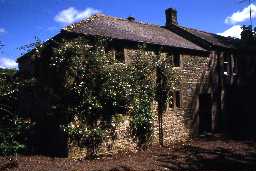Local History
Netherton with Biddlestone (Northumberland)

A possibly 19th century stable with reset 15th to 17th century features at Low Trewhitt, Snitter. Photo by Peter Ryder.
Netherton parish lies in central Northumberland between the River Coquet and the Cheviot Hills. The land rises gradually throughout the parish quite gently, but almost continually, to the north-west.
The earliest remains found in the parish are several Neolithic stone axes found at Low Burradon and Burradon. One is made of flint and shows people had contacts over a wide distance as it is does not naturally occur here.
More is known about the Bronze Age as several burial sites have been found. A round barrow at Low Trewhitt covered a cist, whilst another cist from Low Trewhitt was found with no covering barrow. Excavation of some of these remains found bones and grave goods. So far, no contemporary settlements have been found; cultivation since the Bronze Age may have destroyed all traces of their timber or stone circular huts and their fields.
Although the parish lies north of Hadrian's Wall there are a few sites built by the Roman army. They include a Roman road linking the forts at High Rochester and Low Learchild, which runs through the parish and Yardhope temporary camp. A native settlement may have stood on Chester Hill although it could be earlier, possibly Iron Age in date.
One spectacular early medieval find from the parish is a spearhead from Burradon. Unparalleled in Northumberland, it was recorded by 19th century antiquarians but does not appear to have been associated with a burial or settlement.
More people seem to have lived in the parish in medieval times as there were villages and hamlets at Burradon, Netherton and High Trewhitt. As this was also a time of warfare between England and Scotland tower houses were built at Low Trewhitt and possibly Burradon for protection.
Most of the post-medieval landscape was given over to farming. Elegant country houses were built here, such as Burradon Hall and Trewhitt Hall. An unusual feature near Netherton is a possible cockpit. The falling nature of the ground was used to good advantage by the building of a millpond to the east of Netherton for one of the earliest hydroelectric small schemes in the county at Netherton Burnfoot.
The earliest remains found in the parish are several Neolithic stone axes found at Low Burradon and Burradon. One is made of flint and shows people had contacts over a wide distance as it is does not naturally occur here.
More is known about the Bronze Age as several burial sites have been found. A round barrow at Low Trewhitt covered a cist, whilst another cist from Low Trewhitt was found with no covering barrow. Excavation of some of these remains found bones and grave goods. So far, no contemporary settlements have been found; cultivation since the Bronze Age may have destroyed all traces of their timber or stone circular huts and their fields.
Although the parish lies north of Hadrian's Wall there are a few sites built by the Roman army. They include a Roman road linking the forts at High Rochester and Low Learchild, which runs through the parish and Yardhope temporary camp. A native settlement may have stood on Chester Hill although it could be earlier, possibly Iron Age in date.
One spectacular early medieval find from the parish is a spearhead from Burradon. Unparalleled in Northumberland, it was recorded by 19th century antiquarians but does not appear to have been associated with a burial or settlement.
More people seem to have lived in the parish in medieval times as there were villages and hamlets at Burradon, Netherton and High Trewhitt. As this was also a time of warfare between England and Scotland tower houses were built at Low Trewhitt and possibly Burradon for protection.
Most of the post-medieval landscape was given over to farming. Elegant country houses were built here, such as Burradon Hall and Trewhitt Hall. An unusual feature near Netherton is a possible cockpit. The falling nature of the ground was used to good advantage by the building of a millpond to the east of Netherton for one of the earliest hydroelectric small schemes in the county at Netherton Burnfoot.
N13827
UNCERTAIN
Disclaimer -
Please note that this information has been compiled from a number of different sources. Durham County Council and Northumberland County Council can accept no responsibility for any inaccuracy contained therein. If you wish to use/copy any of the images, please ensure that you read the Copyright information provided.